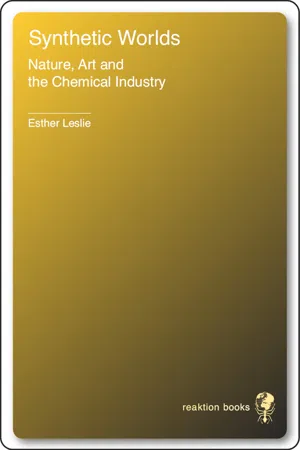![]()
References
introduction
1 Thomas Pynchon, Gravity’s Rainbow (1973;London, 1995), p. 48.
2 Ibid., p. 164.
3 Ibid., p. 166.
4 One crucial source for the chemical details was Williams Haynes’s chatty narrative in This Chemical Age: The Miracle of Man-Made Materials (New York, 1942). Another was Richard Sasuly, IG Farben (New York, 1947).
5 Pynchon, Gravity’s Rainbow, p. 166.
6 Ibid., p. 167.
7 Ibid.
8 Theodor W. Adorno and Max Horkheimer, Dialectic of Enlightenment (1944;London, 1995).
9 Karl Marx, The Eighteenth Brumaire of Louis Bonaparte (1852) (London, 1984), p. 36.
10 The essay can be found in English in Stephen Bronner and Douglas Kellner eds, Critical Theory and Society: A Reader (New York, 1989), pp. 77–94. This quotation is on p. 78.
11 See the quotation from Leon Battista Alberti in Michael Baxandall, Painting and Experience in Fifteenth Century Italy (Oxford, 1988), p. 16.
12 See Karl Marx, Capital, vol. I (New York, 1906), p. 84.
13 Ibid., p. 87.
14 See Pynchon, Gravity’s Rainbow, p. 167.
15 Negative Dialectics appeared in 1966, but Adorno noted that aspects of the book stemmed from the 1930s. See his editorial note on the German second edition.
16 See Adorno and Horkheimer, Dialectic of Enlightenment, p. 138. In German, Dialektik der Aufklärung, in Gesammelte Schriften, vol. III (Frankfurt am Main, 1986), p. 160.
17 Sasuly, IG Farben, pp. 4–5.
18 See Eric Schlosser, Fast Food Nation: What the All-American Meal is Doing to the World (Harmondsworth, 2001), p. 17. For more recent developments in relation to Chicken McNuggets, see p. 139.
19 Theodor W. Adorno, Aesthetic Theory (London, 1984), pp. 100–01; in German, Ästhetische Theorie, in Gesammelte Schriften, vol. VII (Frankfurt am Main, 1986), p. 107.
20 Walter Benjamin, Selected Writings, vol. IV: 1938–1940 (Cambridge, MA, 2003), p. 338.
21 See Theodor W. Adorno, Negative Dialectics (London, 1973), p. 403. In German, Negative Dialektik, in Gesammelte Schriften, vol. VI (Frankfurt am Main, 1986), p. 395.
22 Ibid., pp. 404–5 (translation modified); German edn, p. 396.
23 Ibid., p. 57 (translation modified); German edn, p. 66.
one
1 See Walter Benjamin, ‘Berliner Kindheit um 1900’(1938), in Gesammelte Schriften, vol. VII, pt 1 (Frankfurt am Main, 1991), pp. 398–400. Another version appears in Berliner Chronik (1932), in Gesammelte Schriften, vol. VI (Frankfurt am Main, 1991, p. 472. It is in English as ‘Berlin Childhood around 1900’, in Walter Benjamin, Selected Writings, vol. III: 1935–1938 (Cambridge, MA, 2002). A Berlin Chronicle of 1932 is in Benjamin, Selected Writings, vol. II: 1927–1934 (Cambridge, MA, 1999), pp. 600–1.
2 See Walter Benjamin, Selected Writings, vol. I: 1913–1926 (Cambridge, MA, 1996), p. 90.
3 Benjamin, ‘Berlin Childhood around 1900’, Selected Writings, vol. III, pp. 358–9. Biedermeier denotes the period from c. 1815–48, and denotes a cosy, domestic, middle-class existence.
4 Walter Benjamin, Notes for Berliner Chronik, in Gesammelte Schriften, vol. VI, p. 800.
5 In 1819 E.T.A. Hoffmann wrote a story about a miner’s death at Falun in 1670. Others were inspired by the same true story. Heinrich Heine wrote a ballad. Richard Wagner sketched the outline for an opera called Die Bergwerke von Falun. Later Georg Trakl and Franz Führmann used the theme.
6 Their first collection of folk-tales was initiated by Clemens Brentano, who sought out the Grimm brothers’ help in compiling a continuation of his folk songs Des Knaben Wunderhorn (1805).
7 This story – a version of the ‘Open Sesame’ story from the Arabian One Thousand and One Nights – is in the Grimms’ collection of fairy-tales of 1812–15.
8 F. J. Bertuch, Über die Mittel Naturgeschichte gemei...
